SWING 30
Swing 30 is a Futures Trading System Targets Short-Term Gains in S&P 500 and Nasdaq E-mini, & Micro Contracts.
INDEX FUTURES TRADING SYSTEM
- What is Share Trading01
- Key Features of Share Trading02
- Trade Both Long and Short03
- Calculating Profits and/or Losses04
- Share Trading Examples05
- Key Benefits of Shares06
- Margin Lending07
- Risks of Share Trading08
- Styles of Share Trading09
- Tools & Resources10
- How to Open an Account11
- Supported Brokers12
Swing 30 Trading System
Swing 30 is a system totally executed and supervised by MyTradingAdvisor on your trading account.
Our mission is to help our clients gain exposure to the stock market, without having to do any of the heavy lifting themselves. Best part – there are no joining fees and you can have the opportunity to have a professionally built strategy executed on your account.
1. Introducing Swing 30
Swing 30 System: Long only short-term index futures strategy targeting entries into market strength, prioritising early loss cuts and profit runs.
The “Swing 30 System” is tailored for trading S&P 500 and Nasdaq 100 futures, focusing on both e-mini and micro contracts. It adopts a long-only approach, ensuring a linear equity curve and a favorable win-loss ratio by employing profit targets, stop losses, and breakeven stops. The strategy capitalises on initiating positions during market strengths or breakouts, designed for short-term engagements.
Operating as a fully automated mechanism without the need for discretionary decisions, the Swing 30 can be executed on behalf of clients under a predefined strategy execution agreement. This setup minimises the daily management required from the investor, limiting their role to merely overseeing their trades.
The Swing 30 System stands out as an ideal complement to stock portfolio strategies, thanks to its low correlation and diversification benefits. By focusing on different market conditions and timing—ranging from short-term trades lasting about a day to potentially a week—it offers a strategic balance that enhances overall portfolio resilience. The specific entry and exit rules further contribute to this system’s appeal as a diversified investment approach, seamlessly integrating with existing stock portfolios to optimise performance across varying timeframes.
| Swing 30 System | E-Mini Contract | Micro Contract |
|---|---|---|
| Minimum Investment | US$70,500 | US$7,050 |
| Market | E-mini Futures | Micro Futures |
| Average Trade | US$479.31 | US$47.93 |
| Average Trade Length | 1-3 Days | 1-3 Days |
| Percentage Winning Trades | 46.31% | 46.31% |
| Win:Loss Ratio | 2.12 | 2.12 |
2. Why the Stock Index Futures?
The S&P and Nasdaq E-mini and Micro Futures represent innovative financial tools designed to offer traders and investors scalable access to leading US stock indices with reduced capital requirements. These instruments cater to a wide range of participants, from individual retail traders to institutional investors, by providing flexibility, liquidity, and the ability to tailor investment size and risk. E-mini contracts, scaled-down versions of standard futures contracts, along with even smaller Micro Futures, enable precise portfolio management and speculative opportunities. Their round-the-clock trading hours allow market participants to react swiftly to international economic developments, while the security and transparency offered by regulated exchanges add a layer of confidence in these markets.
KEY POINTS:
1
Scalable Investment Options:
E-mini and Micro Futures offer scalable investment opportunities for accessing major US indices, catering to a wide range of investment sizes and risk preferences.
2
Significant Liquidity:
These instruments ensure high liquidity, making it easier for traders to enter and exit positions efficiently.
3
Flexibility in Strategy:
Traders can employ both bullish and bearish strategies, providing the means to hedge existing investments or speculate on future market directions.
4
Extended Trading Hours:
The nearly 24/5 trading availability allows market participants to react promptly to international economic news and events.
5
Regulated Trading Environment:
Being traded on reputable, regulated exchanges, these futures contracts offer a secure and transparent environment for participants.
6
Lower Margin Requirements:
Compared to standard futures contracts, E-mini and Micro Futures have lower margin requirements, thus broadening access to index trading for more investors.
3. Strategic Considerations
When engaging in futures trading, particularly with instruments like the S&P and Nasdaq E-mini and Micro Futures, strategic considerations are paramount to navigating market volatility and managing risk effectively. A foundational strategy involves a deep understanding of market trends and economic indicators. Traders must remain vigilant to global economic developments, earnings reports, and geopolitical events that can influence market movements. Advanced technical analysis tools and market sentiment indicators can also provide valuable insights, helping traders anticipate potential market directions and adjust their positions accordingly.
Risk management is another critical strategic consideration. Given the inherent leverage in futures trading, small market movements can have amplified effects on portfolio performance. Effective risk management strategies include setting stop-loss orders to limit potential losses, employing proper position sizing to avoid overexposure, and diversifying across different asset classes to mitigate risk. Traders should also consider the timing of their trades, aligning entry and exit points with their risk tolerance and market outlook. Establishing a disciplined approach to trading, with clear rules for when to enter or exit a trade, helps in maintaining focus and avoiding emotional decision-making.

Trading Tip: Lastly, the integration of E-mini and Micro Futures into a broader investment portfolio presents a strategic opportunity for diversification and hedging. These instruments can be used to gain exposure to the equity markets without the need to directly purchase stocks, offering a way to hedge against downturns in other portfolio investments or to speculate on market movements with a smaller capital outlay. Additionally, the ability to trade long and short provides flexibility in responding to market conditions, allowing traders to potentially profit from both rising and falling markets. By incorporating these futures into a diversified investment strategy, traders can enhance portfolio resilience against market volatility while pursuing additional growth opportunities.
4. What is the Swing 30 Strategy:
The Swing 30 Strategy, a cutting-edge approach to trading S&P 500 and Nasdaq 100 futures, can be traded on both e-mini and micro contracts and is underpinned by the sophisticated application of machine learning. This strategy leverages 30-minute intraday data, enabling precise identification of optimal entry points during periods of market strength or breakout, with a long-only trading perspective. It is meticulously designed to exploit short-term market fluctuations while achieving a favorable win-loss ratio through the strategic use of profit targets, stop losses, and breakeven stops for risk management. What sets the Swing 30 Strategy apart is its foundation in machine learning algorithms, which analyse market price action and identify suitable entry and exit points.
DATA INFO:
The strategy uses data from the S&P500 and Nasdaq 100 intraday futures market, analysing 30 minute data of the full trading session.
5. The Rules
The Swing 30 Strategy operates on a set of predefined rules for entering and exiting trades in the S&P 500 and Nasdaq 100 futures markets, using e-mini and micro contracts. Here's a breakdown of these rules in plain English, based on the provided TradeStation Easy Language code:
Entry Rules:
- Time Window: Trades are only initiated within a specified timeframe during the day, ensuring that the strategy capitalises on the most liquid market hours to maximise the efficiency of entry and exit points.
- Market Strength or Breakouts: The system looks to enter trades during periods of market strength or when a breakout is detected. This is determined using machine learning algorithms that analyse 30-minute intraday data, identifying patterns that suggest an imminent rise in prices.
- Indicator Crosses: Entry decisions are also based on the crossing of certain technical indicators, which are mathematical calculations based on the price, volume, or open interest of a market. These indicators help to identify trends and turning points.
Exit Rules:
- Profit Targets and Stop Losses: The strategy uses predefined profit targets and stop losses to automatically close positions. A profit target is a predetermined point at which a trade will be closed to secure profits, while a stop loss is set to limit potential losses if the market moves against the position.
- Breakeven Stops: Once a trade has moved in favor by a certain amount, a breakeven stop can be activated. This adjusts the stop loss to the entry price, ensuring that if the market reverses, the trade will not result in a loss.
- Special Conditions Exit: The strategy includes provisions for exiting trades based on special conditions detected by its machine learning component. These could be indicators of a significant market reversal or other risk factors that warrant cutting losses early or taking profits sooner than planned.
Each of these rules contributes to a systematic approach designed to manage risk and capitalise on market opportunities efficiently. By adhering to these entry and exit parameters, the Swing 30 Strategy aims to maintain a balance between securing profits and limiting losses, based on the predictive power of machine learning and the strategic use of technical indicators.

6. How it Works in Practice
Remember, while strategies like Swing 30 can provide great trade setups, they're not foolproof. Market conditions can at times be unfavorable, and risk management is crucial. Always be prepared for the possibility of loss.
IDENTIFY OPPORTUNITY
Use the rules to find stocks that have hit a low point according to the strategy’s criteria.
ENTER THE TRADE:
Buy the stock when it meets the entry conditions.
SET PROFIT TARGET
Know in advance what the profit target is, based on the strategy’s profit target rule.
EXIT STRATEGY:
Sell the stock when it reaches the profit target or if any conditions suggest it’s time to exit to minimise losses.
OUTSOURCE YOUR TRADE EXECUTION
This strategy is fully mechanical which allows you to outsource the management of the strategy on your account to MyTradingAdvisor. MTA will monitor the system on a day to day basis and execute the orders for the system on your account according to the terms and condition in the Strategy Execution Document.
7. Risk Management
In the context of trading futures with the Swing 30 Strategy, risk management takes on a critical role due to the inherent leverage and volatility associated with futures contracts. The strategy employs several key mechanisms to manage risk and protect trading capital effectively.
The use of stop-loss orders is a fundamental risk management tool within the strategy. These orders are designed to limit potential losses by automatically closing out positions at predetermined price levels if the market moves against the trader’s position. This tool is invaluable for preserving capital by preventing large, uncontrolled losses.
Furthermore, the strategy employs profit targets and breakeven stops to secure gains and further mitigate risk. Profit targets allow traders to lock in earnings at specified levels, while breakeven stops adjust the stop-loss orders to the entry price once a trade has moved in the trader’s favor, protecting against the loss of accumulated profits if the market reverses.
Lastly, the Swing 30 Strategy leverages machine learning algorithms to analyze market data and identify optimal entry and exit points. This data-driven approach enhances the ability to enter and exit trades at the most opportune times, reducing the risk of entering or staying in unfavorable positions. By combining these risk management techniques, the Swing 30 Strategy aims to minimise losses, protect gains, and achieve a favorable risk-reward ratio for traders in the volatile futures market.
8. Strategy Statistics
Comprehensive Trading Performance Analysis Report
This section provides an in-depth analysis of our trading system’s performance, showcasing metrics like net profit, risk assessment, and efficiency. It details the outcomes of trading strategies involving the S&P 500 E-mini and Nasdaq 100 E-mini futures, emphasising profitability, drawdowns, and risk management. Through this report, traders can gain insights into the system’s effectiveness and make informed decisions.
You can hover over each section to view drill down on performance, such as Annual, Monthly, Weekly, Equity Graphs etc.
Swing 30 Aggregate System Report
- 1 Contract S&P 500 Emini Swing 30 System
- 1 Contract Nasdaq 100 E-mini Swing 30 System with Profit Target 1.
- 1 Contract Nasdaq 100 E-mini Swing 30 System with Profit Target 2.
- Please note for traders with smaller capital you can trade Micro contracts.
- To calculate the Micro contract performance and capital requirements divide the numbers in the report below by 10. For instance, the maximum drawdown will be $2,122 ($21,220/10).
- Note Micro contracts are separate contracts, so historical performance will not be exactly the amount shown below divided by ten but should result in a relatively accurate approximation.
OVERALL PERFORMANCE SUMMARY
- Assumptions: 1 contract each per trade on the S&P500 Emini contract, and 2 contracts on the Nasdaq 100 Emini.
- Total Net Profit: $695,477.50 – Net earnings after subtracting losses.
- Max Drawdown: $21,220.00 – Largest decrease in account value, indicating risk level.
- Gross Profit: $1,530,147.50 – Total from winning trades.
- Gross Loss: $834,670.00 – Total from losing trades.
- Profit Factor: 1.833 – Efficiency of the strategy, where greater than 1 is profitable.
- Pessimistic RR: 1.702 – Measures risk-reward balance, higher is better.
- Total Trades: 1451 – Total number of trades executed.
- % Profitable: 46.31% – Percentage of trades that were profitable.
- Avg. Trade Net Profit: $479.31 – Average net profit per trade.
- Max Intraday Drawdown: $23,193.00 – Largest same-day loss.
- Recovery Factor: 32.77 – Effectiveness of the strategy to recover from drawdowns.
- Sharpe Ratio: 0.571 – Measures risk-adjusted return, higher is better.
Individual Market Performance Reports
The performance report above shows the portfolio performance for all 3 strategies. Below we show the system performance broken down into each individual market.
You can hover over each section to view drill down on performance, such as Annual, Monthly, Weekly, Equity Graphs etc.
Swing 30 S&P 500 E-mini System Report
- 1 Contract S&P 500 Emini Swing 30 System
- Please note for traders with smaller capital you can trade Micro contracts.
- To calculate the Micro contract performance and capital requirements divide the numbers in the report below by 10 as micro contracts are 1/10 the size of E-mini contracts.
- Note Micro contracts are separate contracts, so historical performance will not be exactly the amount shown below divided by ten but should result in a relatively accurate approximation.
You can hover over each section to view drill down on performance, such as Annual, Monthly, Weekly, Equity Graphs etc.
Swing 30 Nasdaq 100 E-mini System Report with Profit Target 1
- 1 Contract Nasdaq 100 E-mini Swing 30 System with Profit Target 1
- Please note for traders with smaller capital you can trade Micro contracts.
- To calculate the Micro contract performance and capital requirements divide the numbers in the report below by 10 as micro contracts are 1/10 the size of E-mini contracts.
- Note Micro contracts are separate contracts, so historical performance will not be exactly the amount shown below divided by ten but should result in a relatively accurate approximation.
You can hover over each section to view drill down on performance, such as Annual, Monthly, Weekly, Equity Graphs etc.
Swing 30 Nasdaq 100 E-mini System Report with Profit Target 2
- 1 Contract Nasdaq 100 E-mini Swing 30 System with Profit Target 2
- Please note for traders with smaller capital you can trade Micro contracts.
- To calculate the Micro contract performance and capital requirements divide the numbers in the report below by 10 as micro contracts are 1/10 the size of E-mini contracts.
- Note Micro contracts are separate contracts, so historical performance will not be exactly the amount shown below divided by ten but should result in a relatively accurate approximation.
9. Examples
S&P E-Mini Contract Trade - Example 1
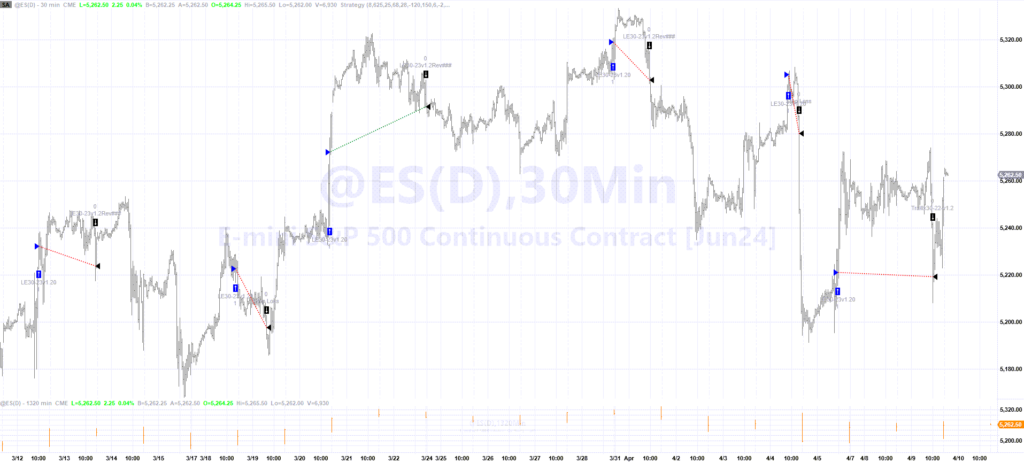
S&P E-Mini Contract Trade - Example 2
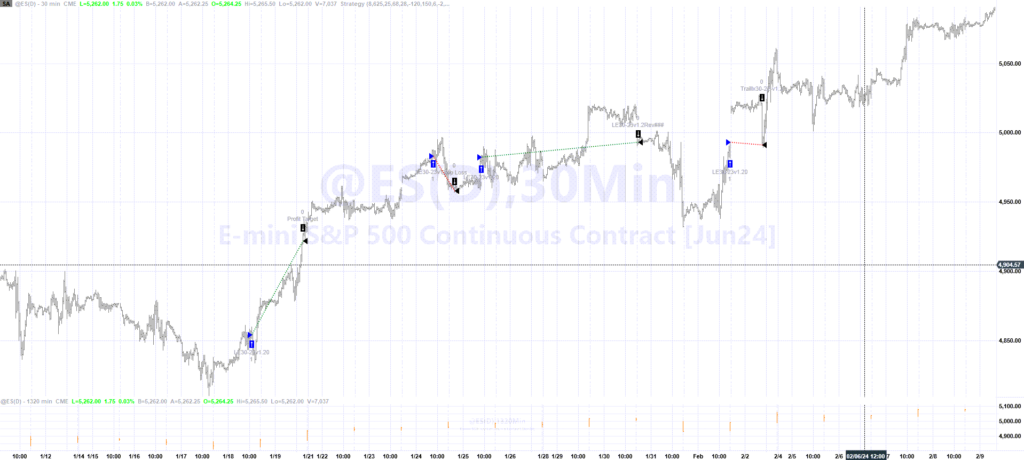
S&P E-Mini Contract Trade - Example 3
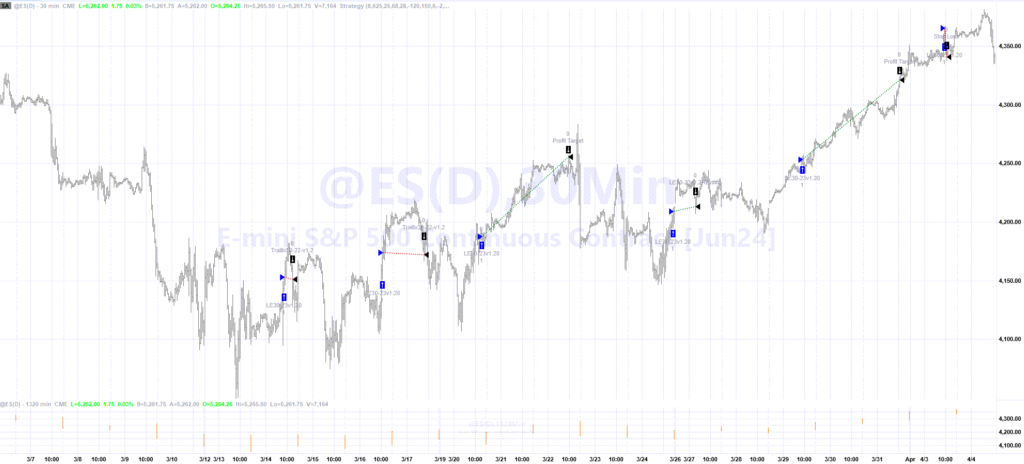
Nasdaq E-Mini Contract Trade - Example 4
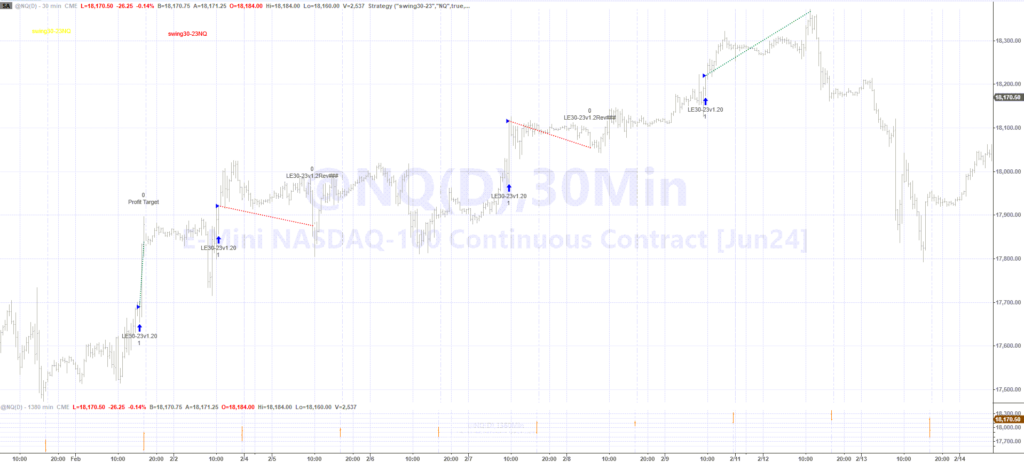
Nasdaq E-Mini Contract Trade - Example 5
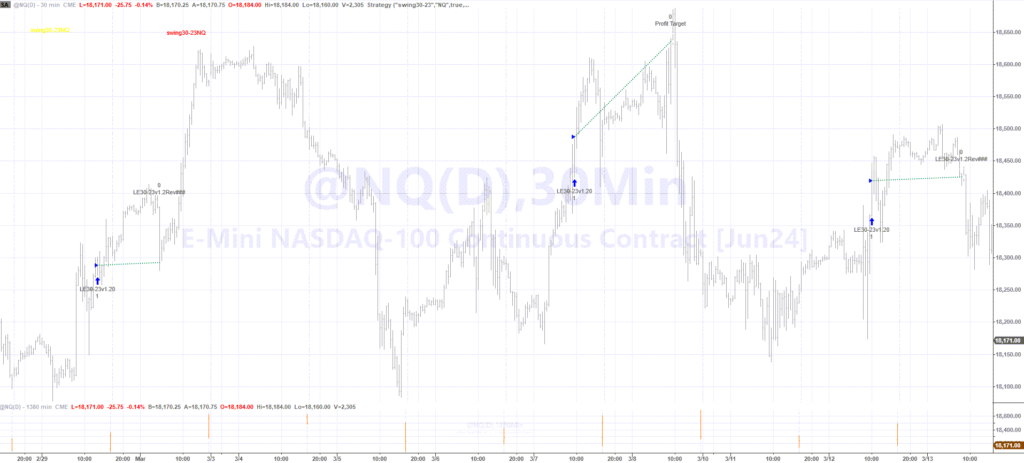
TO PROCEED CLICK "SIGN UP NOW"
The Swing 30 Strategy is a robust system, with the rules showing a strong historical positive expectancy. For traders seeking to amplify their investment portfolios this strategy is particularly enticing due to its strong performance metrics.
Investors interested in a disciplined and tested approach to trading, with clear historical evidence of success, should consider the Swing 30 Strategy as a compelling option for their short-term trading endeavours. It’s an opportunity to participate in a robust strategy that has the potential to demonstrate resilience and profitability over time.
To have this strategy executed for you on your trading account please select the ‘Sign Up Now” button below to proceed. On the next page you will be asked for your name, email and phone number. We will check to see if you have an existing account, if so we will send you our Strategy Execution Agreement. If not we will help you to open an account with Interactive Brokers, which will be linked to MTA so we are able to execute trade on your account once funded.
